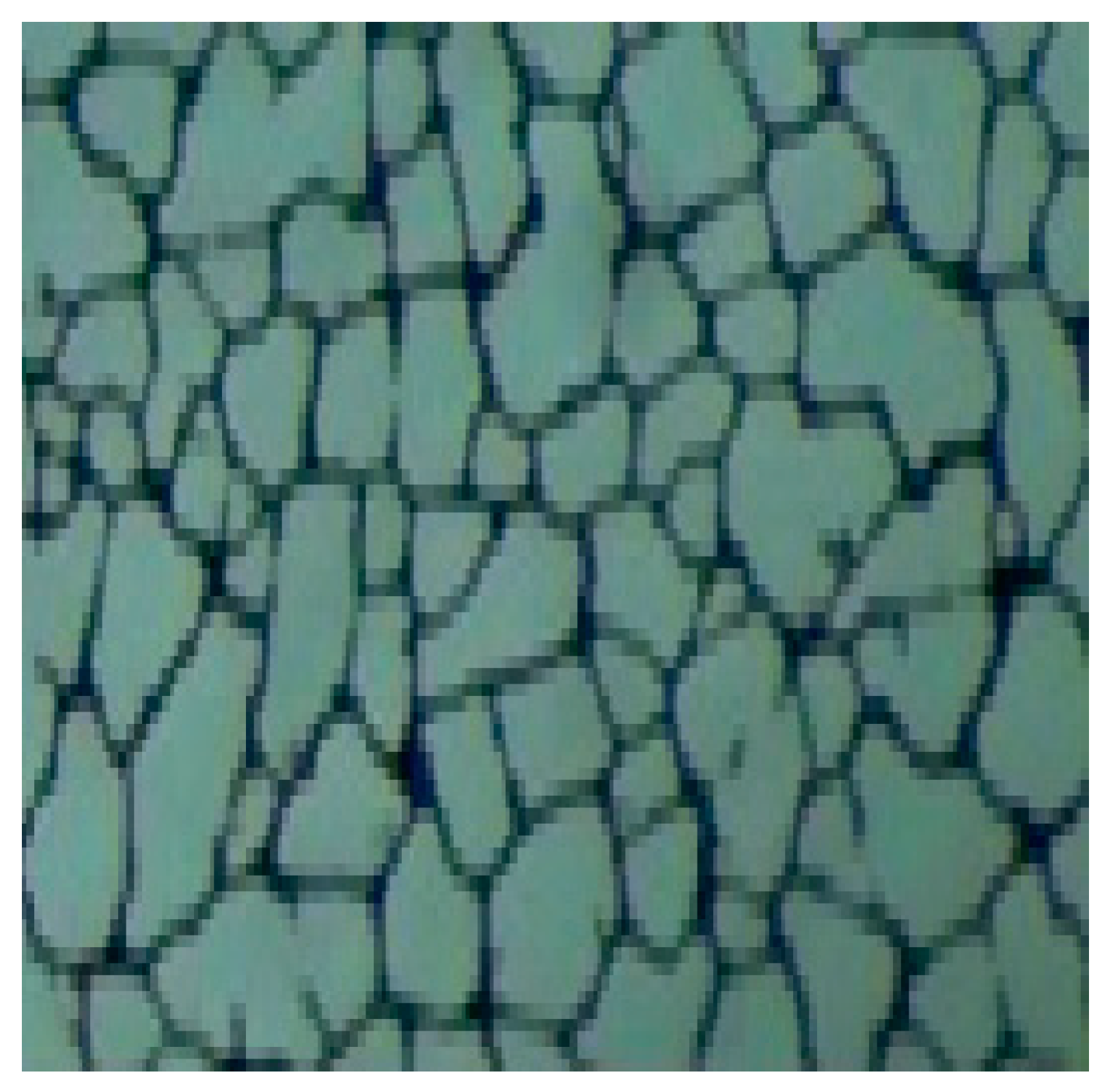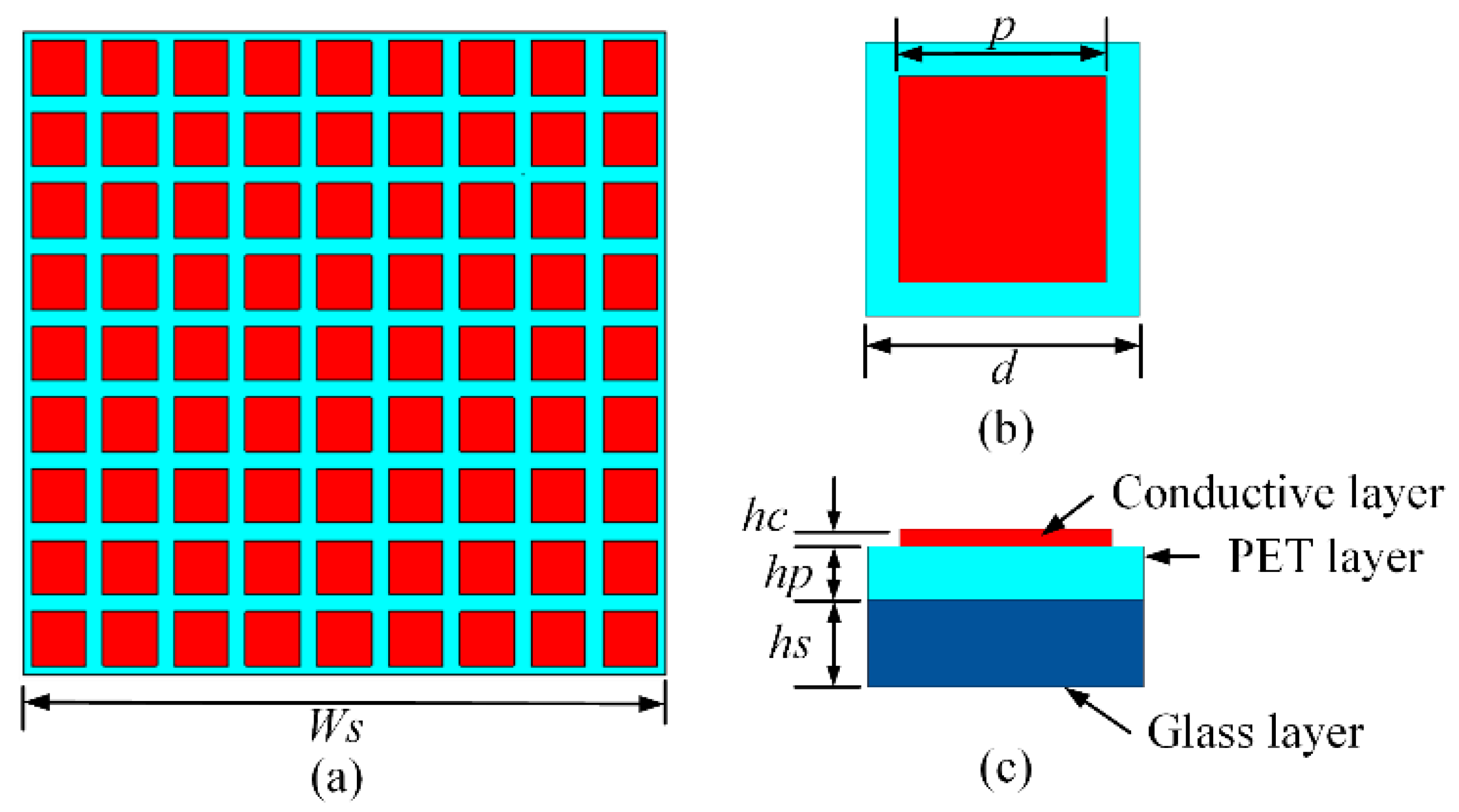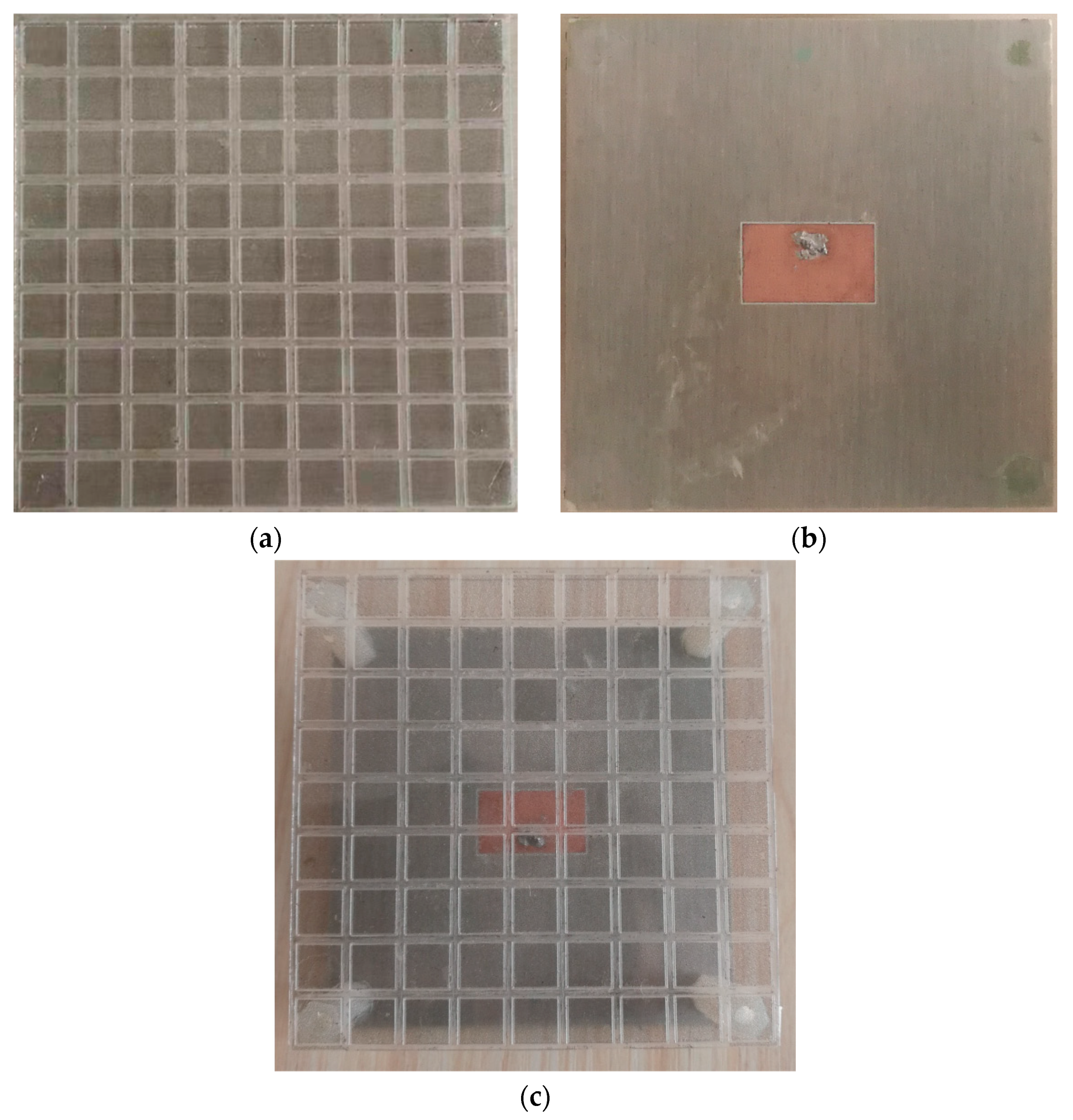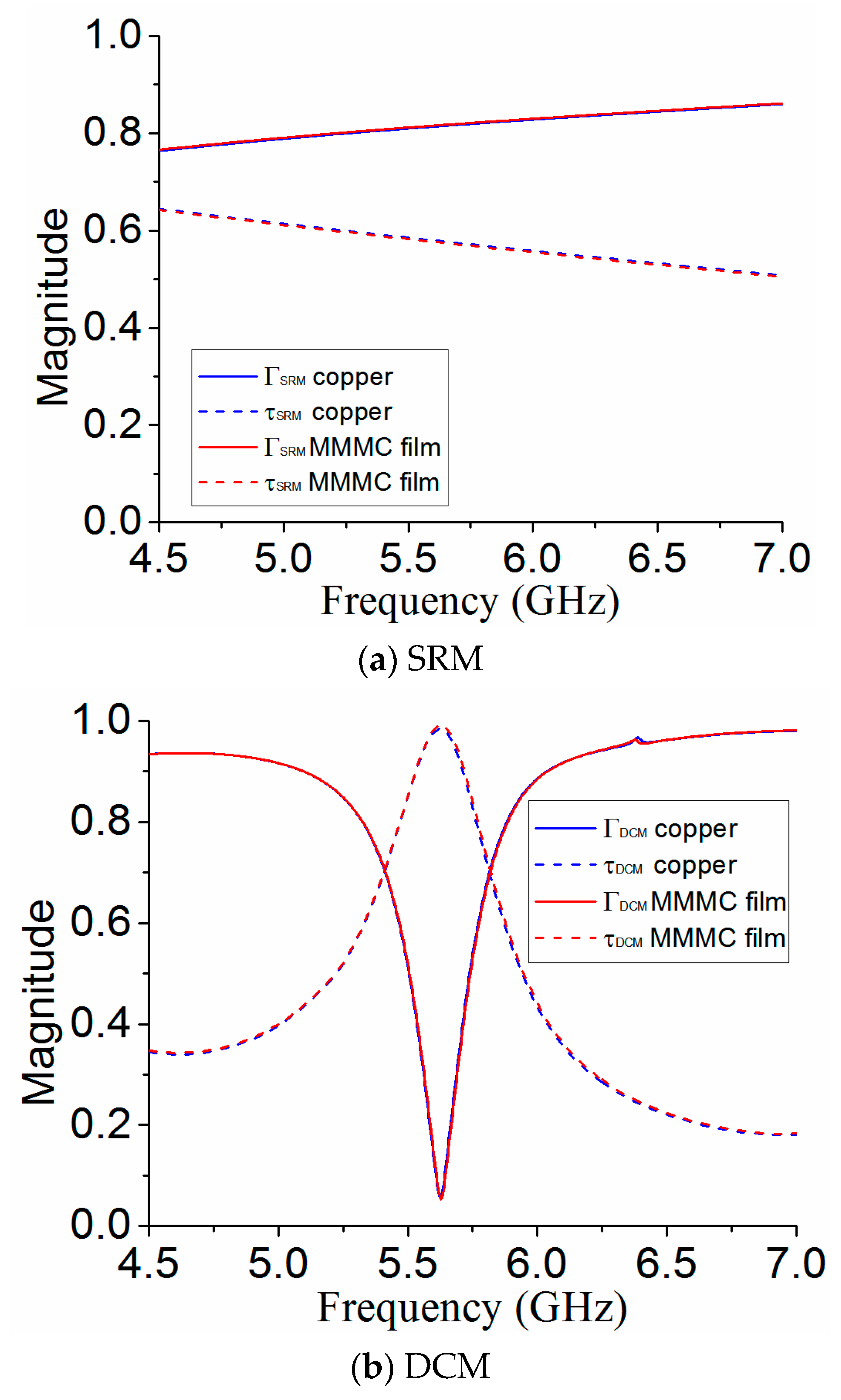An Optically Transparent Metasurface-Based Resonant Cavity Fed by Patch Antenna for Improved Gain
Abstract
:1. Introduction
2. Antenna Design
3. MS Study
3.1. Operation Principle
3.2. Effects of Sheet Resistance
3.3. Comparison with Copper
4. Simulation and Measurement Results
5. Conclusions
Author Contributions
Funding
Conflicts of Interest
References
- Li, G.; Zhai, H.; Li, L.; Liang, C.; Yu, R.; Liu, S. AMC-Loaded Wideband Base Station Antenna for Indoor Access Point in MIMO System. IEEE Trans. Antennas Propag. 2015, 2, 525–532. [Google Scholar] [CrossRef]
- Sayanskiy, A.; Glybovski, S.; Akimov, V.P.; Filonov, D.; Belov, P.; Meshkovskiy, I. Broadband 3-D Luneburg Lenses Based on Metamaterials of Radially Diverging Dielectric Rods. IEEE Antennas Wirel. Propag. Lett. 2017, 16, 1520–1523. [Google Scholar] [CrossRef]
- Brocker, D.E.; Turpin, J.P.; Werner, P.L.; Werner, D.H. Optimization of Gradient Index Lenses Using Quasi-Conformal Contour Transformations. IEEE Antennas Wirel. Propag. Lett. 2014, 13, 1787–1791. [Google Scholar] [CrossRef]
- Zhou, C.F.; Cheung, S.W.; Li, Q.L.; Li, M. Bandwidth and gain improvement of a crossed slot antenna with metasurface. Appl. Phys. Lett. 2017, 110, 211603. [Google Scholar] [CrossRef]
- Saikia, M.; Ghosh, S.; Srivastava, K.V. Design and Analysis of Ultrathin Polarization Rotating Frequency Selective Surface Using V-Shaped Slots. IEEE Antennas Wirel. Propag. Lett. 2017, 16, 2022–2025. [Google Scholar] [CrossRef]
- Li, Y.; Cao, Q.S.; Wang, Y. A Wideband Multifunctional Multilayer Switchable Linear Polarization Metasurface. IEEE Antennas Wirel. Propag. Lett. 2018, 18, 1314–1318. [Google Scholar] [CrossRef]
- Zhu, H.L.; Cheung, S.W.; Chung, K.L.; Yuk, T.I. Linear-to-Circular Polarization Conversion Using Metasurface. IEEE Trans. Antennas Propag. 2013, 61, 4615–4623. [Google Scholar] [CrossRef]
- Ali, L.; Li, Q.L.; Khan, T.A.; Yi, J.; Chen, X. Wideband RCS Reduction Using Coding Diffusion Metasurface. Material 2019, 12, 2708. [Google Scholar] [CrossRef]
- Li, Q.L.; Cheung, S.W.; Wu, D.; Yuk, T.I. Optically Transparent Dual-Band MIMO Antenna Using Micro-Metal Mesh Conductive Film for WLAN System. IEEE Antennas Wirel. Propag. Lett. 2017, 16, 920–923. [Google Scholar] [CrossRef]
- Sa’ad, B.M.; Rahim, S.K.A.; Peter, T.; Rani, M.S.B.A.; Ausordin, S.F.; Zaidel, D.N.A.; Krishnan, C. Transparent Branch-Line Coupler Using Micro-Metal Mesh Conductive Film. IEEE Microw. Wirel. Compon. Lett. 2014, 24, 857–859. [Google Scholar] [CrossRef]
- Sa’ad, B.M.; Rahim, S.K.A.; Peter, T. Transparent 0° phase shifter using micro-metal mesh conductive film. Electron. Lett. 2015, 51, 841–843. [Google Scholar] [CrossRef]
- Serra, C.C.; Medeiros, C.R.; Costa, J.R.; Fernandes, C.A. Mirror-Integrated Transparent Antenna for RFID Application. IEEE Antennas Wirel. Propag. Lett. 2011, 10, 776–779. [Google Scholar] [CrossRef]
- Hakimi, S.; Rahim, S.K.A.; Abedian, M.; Noghabaei, S.M.; Khalily, M. CPW-Fed Transparent Antenna for Extended Ultrawideband Applications. IEEE Antennas Wirel. Propag. Lett. 2014, 13, 1251–1254. [Google Scholar] [CrossRef]
- Zeb, B.A.; Hashmi, R.M.; Esselle, K.P. Wideband gain enhancement of slot antenna using one unprinted dielectric superstrate. Electron. Lett. 2015, 51, 1146–1148. [Google Scholar] [CrossRef]
- Yahiaoui, R.; Burokur, S.N.; Lustrac, A. Enhanced directivity of ultra-thin metamaterial-based cavity antenna fed by multisource. Electron. Lett. 2009, 45, 814–816. [Google Scholar] [CrossRef]
- Burokur, S.N.; Yahiaoui, R.; Lustrac, A. Subwavelength metamaterial-based resonant cavities fed by multiple sources for high directivity. Microw. Opt. Techn. Lett. 2009, 51, 1883–1888. [Google Scholar] [CrossRef]
- Yahiaoui, R.; Burokur, S.N.; Vigneras, V.; Lustrac, A.; Mounaix, P. Investigation of spatial filters at microwave frequencies: Application for antenna directivity enhancement. Microw. Opt. Techn. Lett. 2012, 54, 1327–1332. [Google Scholar] [CrossRef]
- Trentini, G.V. Partially Reflecting Sheet Arrays. IRE Trans. Antennas Propag. 1956, 4, 666–671. [Google Scholar] [CrossRef]
- Ge, Y.; Esselle, K.P.; Bird, T.S. The Use of Simple Thin Partially Reflective Surfaces with Positive Reflection Phase Gradients to Design Wideband, Low-Profile EBG Resonator Antennas. IEEE Trans. Antennas Propag. 2012, 60, 743–750. [Google Scholar] [CrossRef]
- Thevenot, M.; Cheype, C.; Reineix, A.; Jecko, B. Directive Photonic-Bandgap Antennas. IEEE Trans. Microw. Theory Tech. 1999, 47, 2115–2122. [Google Scholar] [CrossRef]
- Feresidis, A.P.; Vardaxoglou, J.C. High gain planar antenna using optimised partially reflective surfaces. IET Microw. Antennas Propag. 2001, 148, 345–350. [Google Scholar] [CrossRef]
- Hashmi, R.M.; Zeb, B.A.; Esselle, K.P. Wideband High-Gain EBG Resonator Antennas with Small Footprints and All-Dielectric Superstructures. IEEE Trans. Antennas Propag. 2014, 62, 2970–2977. [Google Scholar] [CrossRef]













| Ws | Wp | Lp | p | d | h | hc | hp | hs |
|---|---|---|---|---|---|---|---|---|
| 81 | 22 | 13 | 9 | 6.8 | 29.5 | 0.005 | 0.012 | 1 |
© 2019 by the authors. Licensee MDPI, Basel, Switzerland. This article is an open access article distributed under the terms and conditions of the Creative Commons Attribution (CC BY) license (http://creativecommons.org/licenses/by/4.0/).
Share and Cite
Li, Q.; Chen, X.; Hu, X. An Optically Transparent Metasurface-Based Resonant Cavity Fed by Patch Antenna for Improved Gain. Materials 2019, 12, 3805. https://doi.org/10.3390/ma12233805
Li Q, Chen X, Hu X. An Optically Transparent Metasurface-Based Resonant Cavity Fed by Patch Antenna for Improved Gain. Materials. 2019; 12(23):3805. https://doi.org/10.3390/ma12233805
Chicago/Turabian StyleLi, Qinlong, Xiaoming Chen, and Xin Hu. 2019. "An Optically Transparent Metasurface-Based Resonant Cavity Fed by Patch Antenna for Improved Gain" Materials 12, no. 23: 3805. https://doi.org/10.3390/ma12233805





